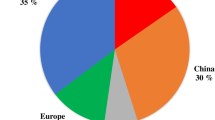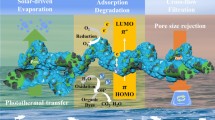Abstract
In this work, permeation of mixed gases H2S/CH4 through commercial polyphenylene oxide (PPO) hollow fiber and poly (ester urethane) urea (PEUU) flat membranes was studied at pressures of 345–689 kPa, at ambient temperature and at 313.15 K. Various H2S concentrations of about 100–5000 ppm in CH4 binary synthetic gas mixtures as well as a real natural gas sample obtained from a gas refinery containing 0.3360 mol.% H2S (equivalent to 3360 ppm) were tested. It was observed that the permeance of components was affected by the balance between competitive sorption and plasticization effects. Separation factors of H2S/CH4 were in the range of 1.3–2.9, 1.8–3.1 and 2.2–4.3 at pressures of 345, 517 and 689 kPa, respectively. In the range of 101–5008 ppm of H2S in CH4, the effect of temperature on the separation factor was nearly negligible; however, permeances of both components of the mixtures increased with temperature. Additionally, the results obtained by PEUU membrane indicated that it was a better choice for hydrogen sulfide separation from H2S/CH4 mixtures than PPO. For PPO membrane, removal of hydrogen sulfide from high-concentration (up to 5008 ppm) binary mixtures of H2S/CH4 was compared with that of low concentration (as low as 101 ppm) through PPO. At concentrations of 101–968 ppm, plasticization was dominant compared with the competitive sorption, while for the H2S feed concentrations of 3048 ppm, the competitive sorption effect was dominant. For H2S concentration of 5008 ppm, the balance between these two effects played an important role for explanation of its trend.








Similar content being viewed by others
Abbreviations
- A [m2]:
-
Membrane permeation area
- l [m]:
-
Membrane thickness
- p [Pa]:
-
Pressure
- (P/l) [mol m−2 s−1 Pa−1]:
-
Permeance of gas
- Q [m3 (STP).s−1]:
-
Permeate flow rate
- T [K]:
-
Temperature
- (\(\bar{x}_{i}\))ln :
-
Logarithmic average mole fraction of gas i in feed
- x i,F :
-
Mole fraction of gas i in feed
- x i,R :
-
Mole fraction of gas i in retentate
- y i :
-
Mole fraction of gas i in permeate
- α ij :
-
Separation factor of gas i over gas j
- \(\alpha_{ij}^{o}\) :
-
Ideal selectivity of gas i over gas j
- F :
-
Feed side
- g :
-
Glass transition
- i :
-
Index of gas component i (here is H2S)
- j :
-
Index of gas component j (here is CH4)
- P :
-
Permeate side
- R :
-
Retentate side
References
Aguilar-Vega M, Paul DR (1993) Gas transport properties of polyphenylene ethers. J Polym Sci Part B Polym Phys 31(11):1577–1589. doi:10.1002/polb.1993.090311114
Baker RW (2004) Membrane technology and applications, 2nd edn. Wiley, Hoboken
Bhide BD, Stern SA (1993) Membrane processes for the removal of acid gases from natural gas. I. Process configurations and optimization of operating conditions. J Membr Sci 81(3):209–237. doi:10.1016/0376-7388(93)85175-V
Chatterjee G, Houde AA, Stern SA (1997) Poly(ether urethane) and poly(ether urethane urea) membrane with high H2S/CH4 selectivity. J Membr Sci 135(1):99–106. doi:10.1016/S0376-7388(97)00134-8
Chou S (2003) Hydrogen sulfide: human health aspects. Concise International Chemical Assessment Document 53. Prepared for the World Health Organization. p. 6
Ettouney H, Majeed U (1997) Permeability functions for pure and mixture gases in silicone rubber and polysulfone membranes: dependence on pressure and composition. J Membr Sci 135(2):251–261. doi:10.1016/S0376-7388(97)00150-6
Ho WSW, Sirkar KK (1992) Membrane handbook, chapter 1. Springer, New York, pp 3–15
Koros WJ, Chern RT, Stannett V, Hopfenberg HB (1981) A model for permeation of mixed gases and vapors in glassy polymers. J Polym Sci Polym Phys Ed 19(10):1513–1530. doi:10.1002/pol.1981.180191004
Mohammadi T, Tavakol Moghadam M, Saeidi M, Mahdyarfar M (2008) Acid gas permeation behavior through poly(ester urethane urea) membrane. J I&EC Res 47(19):7361–7367. doi:10.1021/ie071493k
Paul DR, Yampol’skii YP (1994) Polymeric gas separation membranes. CRC Press, London
Pourafshari Chenar M, Soltanieh M, Matsuura T, Tabe-Mohammadi A, Feng C (2006) Gas permeation properties of commercial polyphenylene oxide and Cardo-type polyimide hollow fiber membranes. J Sep Purif Technol 51(3):359–366. doi:10.1016/j.seppur.2006.02.018
Pourafshari Chenar M, Savoji H, Soltanieh M, Matsuura T, Tabe S (2011) Removal of hydrogen sulfide from methane using commercial polyphenylene oxide and Cardo-type polyimide hollow fiber membranes. Korean J Chem Eng 28(3):902–913. doi:10.1007/s11814-010-0437-7
Savoji H, Rana D, Matsuura T, Soltanieh M, Tabe S (2012) Novel surface modifying macromolecules (SMMs) blended polysulfone gas separation membranes by phase inversion technique. J Appl Polym Sci 124(3):2287–2299. doi:10.1002/app.34809
Vaughn JT, Koros WJ (2014) Analysis of feed stream acid gas concentration effects on the transport properties and separation performance of polymeric membranes for natural gas sweetening: a comparison between a glassy and rubbery polymer. J Membr Sci 465:107–116. doi:10.1016/j.memsci.2014.03.029
Wang R, Liu SL, Lin TT, Chung TS (2002) Characterization of hollow fiber membranes in a permeator using binary gas mixtures. J Chem Eng Sci 57(6):967–976. doi:10.1016/S0009-2509(01)00435-3
Wilks B, Rezac ME (2002) Properties of rubbery polymers for the recovery of hydrogen sulfide from gasification gases. J Appl Polym Sci 85(11):2436–2444. doi:10.1002/app.10881
Acknowledgements
The authors are grateful for the financial support provided by the Directorate for Research and Technology of the National Iranian Gas Company. They are also indebt to M. Mahdiyarfar and Y. Fazli of the Gas Research Division, Research Institute of Petroleum Industry, for their kind assistance in setting up the experimental apparatus. Moreover, the kind assistances of C. Y. Feng, K. C. Khulbe, L. Trembley, and F. Ziroldo of the Department of Chemical Engineering, the University of Ottawa, are acknowledged with thanks. The courtesy of Parker Filtration and Separation B. V. of the Netherlands for providing the membrane samples is highly appreciated.
Author information
Authors and Affiliations
Corresponding author
Additional information
Editorial responsibility: B.V. Thomas.
Experimental results of binary mixtures separation of CH4 at various H2S concentrations from low (~100 ppm) to more than 5000 ppm by PPO and PEUU membranes were presented. Also, tests with a real gas sample containing high concentration of H2S and other impurities have been reported. To our knowledge, very few studies have reported investigations on high concentration of acid gas and real gas separation with these membranes and different configurations.
Rights and permissions
About this article
Cite this article
Niknejad, S.M.S., Savoji, H., Pourafshari Chenar, M. et al. Separation of H2S from CH4 by polymeric membranes at different H2S concentrations. Int. J. Environ. Sci. Technol. 14, 375–384 (2017). https://doi.org/10.1007/s13762-016-1156-3
Received:
Revised:
Accepted:
Published:
Issue Date:
DOI: https://doi.org/10.1007/s13762-016-1156-3




